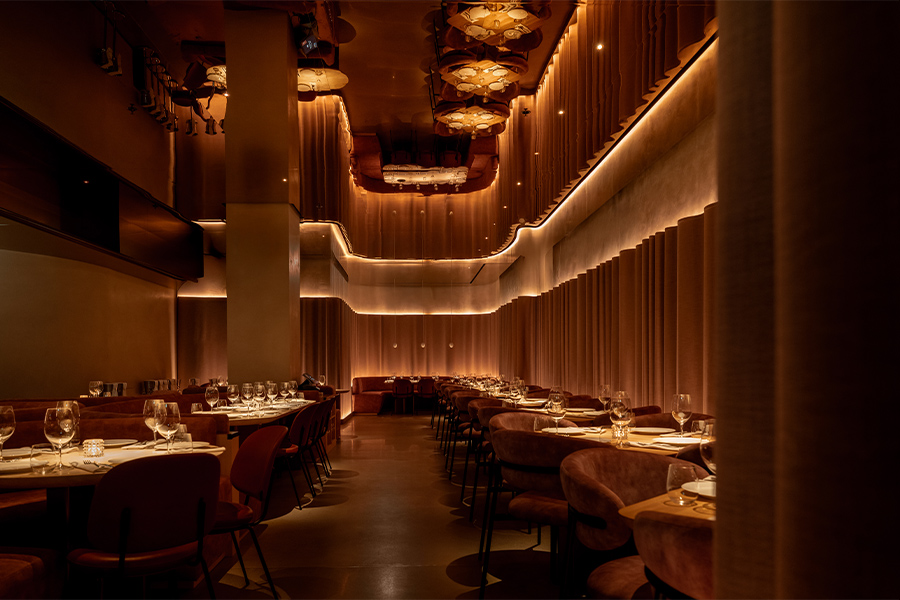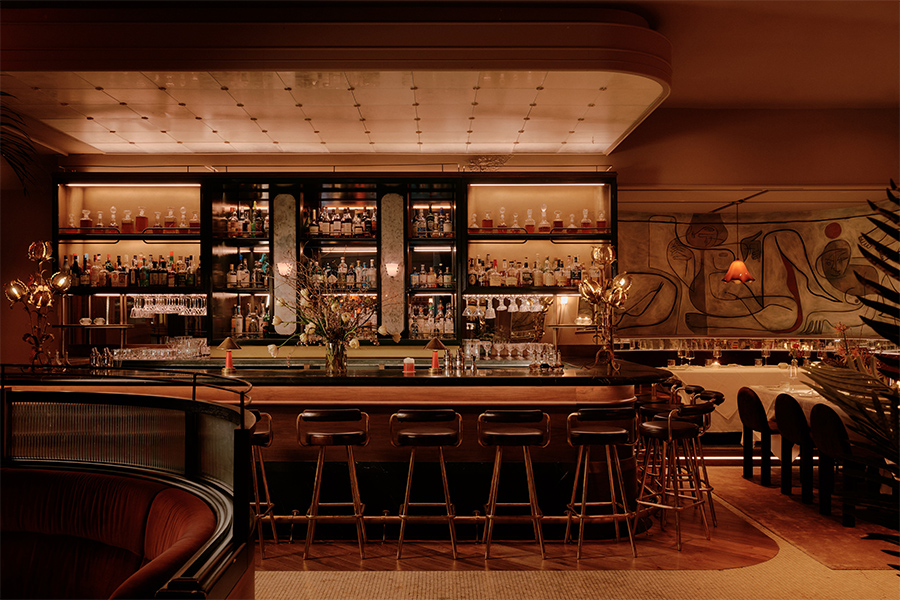As the seasons have changed in New York, so have many of the city’s outdoor dining setups. Although temporary and constructed due to the restrictions that have been placed on restaurants, these structures hardly appear makeshift. Restauranteurs have tapped talented design teams and vendors to create magical ambiences that defy the winter temperatures.
Scarpetta

Hospitality Design partnered with modern Italian restaurant Scarpetta to curate the Scarpetta Chalet. Located at the James New York – NoMad hotel, the semi-enclosed winterized structure seats approximately 60 patrons. Williams-Sonoma, Inc. B2B outfitted the space with mahogany outdoor armchairs, cozy lodge sherpa throws, lanterns, and woven rugs from Pottery Barn, while Valley Forge Fabrics provided custom linen drapery that adds a unique softness and intimacy to the streetside concept. Custom arched glass panel artwork from Kevin Barry Art Advisory and winter greenery arranged by Raquel Corvino Flowers round out the festive décor, and overhead heaters keep guests warm. “The Chalet is our way of accommodating guest safety concerns, without sacrificing the Scarpetta experience,” says John Meadow, president of LDV Hospitality, of the restaurant group’s signature eatery. “Outdoor dining is currently our everything, and even when indoor dining reopens, we plan for it to remain.”
The Greens

Located within Manhattan’s Seaport District, the rooftop at Pier 17 is making the most of its large open-air space with a new iteration of the Greens pop-up concept. The venue is now home to 28 cozy, socially distant cabins created with small groups in mind. The accommodations, designed and built by New York-based experiential agency Relevent in partnership with the Howard Hughes Corporation, can comfortably fit up to 10 people and are disinfected throughly between each 90-minute reservation slot. Described as a “relaxing upstate getaway downtown,” the transparent greenhouse-like structures feature banquette seating, a virtual fireplace, electric heating, and floor-to-ceiling vistas of New York. “We pulled inspiration from cabins in the Catskills, charming mountainside ski towns, and cozy winter lodges to create the Greens winter experience,” says Zach Weinreb, vice president of creative strategy at the Seaport District, Howard Hughes Corporation. “The cabins are arranged to feel like a small winter village with beautiful views of the Brooklyn Bridge and Manhattan skyline.”
Marea

Michelin-starred Italian seafood restaurant Marea has transformed its Under the Sea-themed patio, which was introduced over the summer, into a glamorous après ski-inspired scene at the hand of Nulsa Design. An abundance of floral components were replaced with a backdrop of Alpine spruces, pines, junipers, and conifers arranged beneath the scaffold. Seats are lined with genuine sheepskin throws and also feature concealed individual heaters. The addition of twinkling lights, vintage wooden skis, and standing gas heaters further enhance the surrounding space. “The idea is to escape reality and melt into this atmosphere and enjoy your hot whiskey cider drink, while we continue to try and put a brave face on eating outdoors in sub-zero temperatures,” says the New York firm’s founder Alsún Keogh, who partnered with Altamarea Group owner and CEO Ahmass Fakahany on the design. “If it’s good enough for the European royals on the slopes of Courchevel, it’s definitely good enough for the guests of Marea—and the best part is they won’t have to ski home afterwards!”
Buddakan

Rockwell Group was enlisted to envision a fanciful outdoor environment for Asian-fusion restaurant Buddakan. Taking cues from Tokyo’s popular Tsukiji fish market, the design team mimicked the lively destination’s labyrinth of stalls and trellis of glowing paper lanterns for the 86-seat concept in New York’s Meatpacking District. Wood decking was used to establish a pavilion of built-in seating (that accommodates four-tops and groups of six) and call to mind the clusters of wood crates that punctuate the market. The structure’s awning is emblazoned with Japanese letters, while wooden boxes and planters barrier diners from the street. “Dining out is an important social part of New York City,” says Rockwell Group studio leader Matthew Winter. “Restaurants are places to connect, celebrate, and spend time with others, and we need these spaces now more than ever. Our concept for Buddakan was to create a transportive and immersive outdoor dining experience that revives and reinterprets elements from the restaurant’s indoor environment.”
Read more: Fine Dining Heads Outdoors With New York’s Boulud Sur Mer



